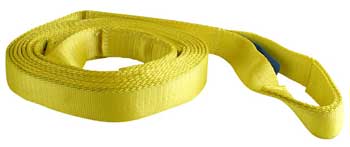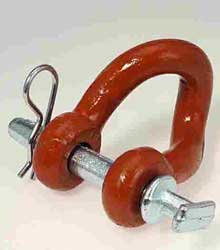Farmer Dies After Being Injured While Attempting To Pull A Machine From A Wet Field
Minnesota Case Report 05MN046
January 24, 2006
Summary
A 46-year-old male farmer (victim) died from injuries sustained while using a four-wheel drive tractor to pull a farm machine from a wet field. Earlier that day a forage chopper operated by a hired worker became stuck in the field. The victim drove a four-wheel drive tractor to the field to pull the chopper from where it was stuck. He hooked one end of a flexible fabric tow strap commonly called a “snap strap” to the chopper and the other end of it to the tractor. A U-shaped clevis and steel pin was used at each end of the strap to connect it to the tractor and the chopper.
While the victim tried to pull the chopper free, the pin in the clevis hooked to the chopper started to bend. As the pin bent, the clevis spread apart and suddenly unhooked. The clevis was propelled toward the tractor, shattered the rear window of the tractor cab and struck the victim.
After being struck, the victim lost control of the tractor and it began to travel across the field. The worker who had been operating the chopper observed the incident and ran to the victim’s nearby farm site. He notified the victim’s brother and two other workers of the incident and then placed a call to emergency personnel. The victim’s brother and the other workers went to the field and found the tractor in an adjacent ditch where it was hung up on a large hay bale.
They stopped the tractor engine and removed the unconscious victim from the tractor cab. They transported him to a local hospital where he died five days later from injuries he sustained during the incident. MN FACE investigators concluded that, in order to reduce the likelihood of similar occurrences, the following guidelines should be followed:
- workers should only use towing components such as chains, clevises and snap straps that can withstand the forces exerted by towing units to which they are connected; and
- workers should hitch towed loads only to the tractor drawbar.
Introduction
On November 3, 2005, MN FACE investigators were notified of a farm work-related fatality that occurred on October 11, 2005. The county sheriff’s department was contacted and a copy of their detailed report of the incident including a witness statement was obtained. A site investigation was not conducted by a MN FACE investigator. During MN FACE investigations, incident information is obtained from a variety of sources such as law enforcement agencies, county coroners and medical examiners, employers, coworkers and family members.
Investigation
On the day of the incident, the victim used a large four-wheel drive tractor to attempt to pull a farm machine from a wet field. Earlier that day a self-propelled forage chopper was being operated by a hired worker to chop standing corn which when chopped is used as a feed for dairy cows. During the two to three week period prior to the incident, heavy rains had resulted in numerous wet spots throughout most farm fields in the area. While operating the chopper, the operator encountered an area of the field through which the chopper could not travel and it became stuck in the wet field.
After the operator of the chopper notified the victim that the chopper was stuck in the field, the victim drove a large four-wheel drive tractor to the field to attempt to pull the chopper from the area where it was stuck. The victim hooked one end of a 3-4 inch wide strong flexible fabric tow strap commonly called a “snap strap” (Figure 1) to the forage chopper and the other end of the strap to the four-wheel drive tractor. A tow strap is a strong flexible fabric band that is several inches wide and typically varies in length up to 30 feet or more. The strength of “new” tow straps, commonly referred to as minimum breaking strength (MBS) depends on the width of the straps and the ply or number of layers and can range from around 20,000 pounds for a 2 inch wide 2 ply strap to over 50,000 pounds for a 4 inch wide 4 ply strap. In addition, the strength of a strap depends on its condition and may be significantly less if a strap has been damaged in any way during prior use. A U-shaped clevis (Figure 2) was used at each end of the tow strap to connect it to the tractor and the chopper. Each U-shaped clevis used a steel pin to connect the clevis to the chopper and the tractor. The clevis shown in Figure 2 has a locking clip which is a light weight clip that is used to prevent the pin from inadvertently being thrown or dislodged from the clevis. In this incident, it was not known whether or not the clevis pins were fitted with locking clips.
 |

|
|
Figure 2. Typical Clevis with Pin and Locking Clip.
|
While the victim tried to pull the stuck chopper free, the pin in the clevis hooked to the chopper started to bend. As the pin bent, the U-shaped clevis spread apart and suddenly unhooked from the chopper. It could not be determined if the clevis pin associated with this incident was secured with a locking clip as shown in Figure 2. However, even if a locking clip had been used, the lightweight clip would not have been of sufficient strength to prevent the clevis from unhooking from the chopper. Due to the energy stored in the tow or “snap strap” while it was under tension, the clevis was propelled toward the tractor and the victim seated in the enclosed cab. The clevis shattered the rear window of the cab, struck the victim and caused him to lose control of the tractor.
After the victim was struck, the four-wheel drive tractor traveled uncontrolled across the cornfield. The worker who had been operating the chopper before it became stuck realized that the victim was not in control of the tractor and attempted to run up to it and get on it while it was moving. As he approached the tractor, he realized that he might be run over by the tractor wheels if he attempted to climb onto it while it was moving. He decided to run to the victim’s nearby farm site to place a call for emergency help. When he got to the farm site, he notified the victim’s brother and two other workers of the incident and then placed a call to emergency personnel.
The victim’s brother and the other workers went to the field and found the tractor in a ditch adjacent to the field where it was hung up on a large hay bale. They stopped the tractor engine and removed the unconscious victim from the tractor cab. They transported him to a local hospital where he died five days later from head injuries he sustained during the incident.
This was the second farm work-related fatality involving a snap strap that has been investigated by the MN FACE program. In each case, the victim was struck by an object that was propelled into the cab of the tractor being operated by the victim. The other incident, MN FACE Case # 96MN040 involved a farmer who also was trying to pull a stuck farm machine from a wet field. Although tow straps offer the advantage of weighing less than conventional steel chains and therefore are easier to carry and handle, they can present an increased risk of injury to workers due to their ability to store a significant amount of energy when under tension. If this energy is suddenly released, the energy can propel items toward workers who if struck, can be seriously injured or killed as in each of these cases.
Cause of Death
The cause of death listed on the death certificate was complications due to severe head trauma due to farm accident.
Recommendations/Discussion
Recommendation #1: Workers should only use towing components such as chains, clevises and snap straps that can withstand the forces exerted by towing units to which they are connected.
Discussion: Whenever workers use towing components such as chains, clevises, tow or “snap straps”, etc. they should only use those that can withstand the forces exerted by the tractor or other towing unit to which they are connected. Modern farm tractors such as the four-wheel drive tractor associated with this incident typically are rated from 200 to over 400 horsepower and are much more powerful than older two-wheel drive tractors. In this incident, the clevis pin that coupled the snap strap to the chopper began to bend when the victim tried to pull the chopper from the field. The bending of the clevis pin indicates that the pin was not of sufficient strength to withstand the forces to which it was exposed by the large four-wheel drive tractor. Whenever farmers and other farm workers are using large horsepower tractors to pull or tow items, they should never use any tools or equipment that was originally designed for use with smaller farm tractors. If workers are in doubt as to whether items can be safely used with large tractors, they should consult with tractor and equipment manufacturers and dealers. After seeking advice from knowledgeable equipment representatives, they need to purchase and use only items of sufficient strength that have been designed for use with tractors of similar size to those with which they intend to use the item. Tow straps such as the one used in this incident are often stamped with the “minimum breaking strength” (for example: 30,000 MBS) when new however, this stamped rating may not remain clearly visible over time if the strap becomes dirty or the stamp is worn off during use. If only items of appropriate strength are used with large horsepower tractors, the risk of items failing during use will be reduce along with a reduction in the risk of workers being injured in the event of a component failure as happened in this case.
Recommendation #2: Workers should hitch towed loads only to the tractor drawbar.
Discussion: The drawbar of a tractor is the safest point on a tractor for pulling towed loads. If a load is connected either directly or indirectly via a chain or other device to other locations on a tractor, dangerous situations may be created. In particular, the potential for a tractor to tip rearward is much greater if a load is hitched to a point above the height of the drawbar. Also, if chains and snap straps are only hooked to the tractor drawbar, thrown objects caused by a breakage or unhooking of a chain or strap may be more likely to remain close to the ground and not travel up toward the operator of the tractor. Although it is not known where the snap strap was hooked to the tractor in this incident, a general safe work practice to follow is to always hitch towed loads to the drawbar.
To contact Minnesota State FACE program personnel regarding State-based FACE reports, please use information listed on the Contact Sheet on the NIOSH FACE web site Please contact In-house FACE program personnel regarding In-house FACE reports and to gain assistance when State-FACE program personnel cannot be reached.
